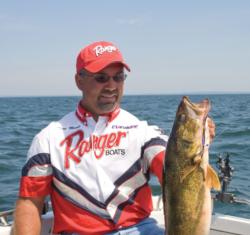Bouncing up bottom
Transmitting bottom contours through lead and line
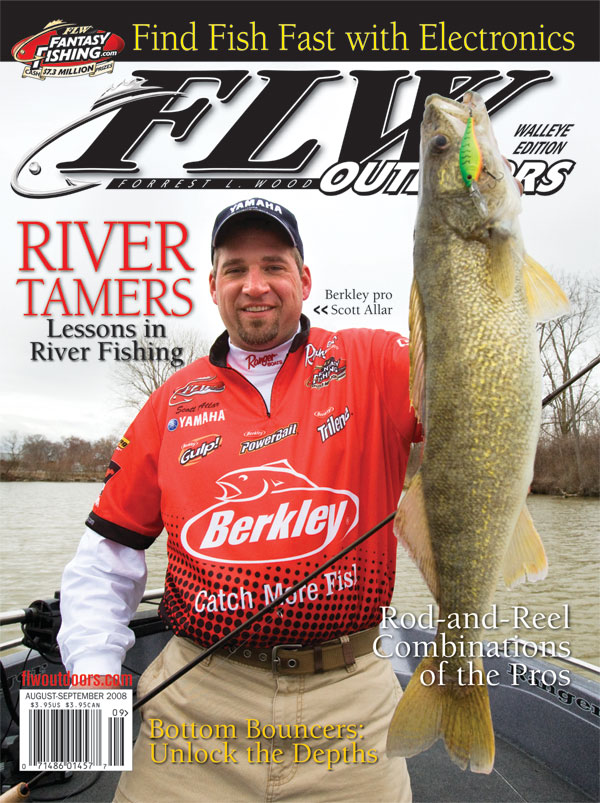
It’s no secret, walleye anglers have embraced technology. Large-megapixel sonar displays, GPS mapping and other electronics have some anglers’ boats rivaling NASA space stations in terms of electronics. And while many of those nifty gadgets were originally developed for a different industry, leave it to walleye anglers to pick up these tools and run wild with them.
But with all of the high-tech equipment anglers have at their fingertips – some so new and advanced they actually require reading the owner’s manual – many forget that good old-fashioned, old-school wisdom and strategy still have a place in this new age fishing world. And it’s those same “prehistoric” tactics that, when combined with new technology, can create a recipe for success, perhaps none more than using a bottom bouncer to accurately read bottom content.
Reading what’s below
As a Land O’Lakes and Ranger pro who fishes the Wal-Mart FLW Walleye Tour Presented by Berkley, Eric Olson of Red Wing, Minn., knows that when it comes to finely tuned boat control, there are some traditional tactics and tools he uses that no technology in the world can completely replace.
“Make no mistake, to be competitive, we have to learn how to use all of the new technology, like GPS mapping and plotting, the new sonar that is available, etc.,” Olson said. “But don’t forget about simple pieces of equipment that enable you to fine-tune even further.”
Simply put, the high-tech gadgets will get anglers close, really close. But no matter how technological a boat is, anglers still rely on something as primitive as an L-shaped wire with a piece of lead attached to 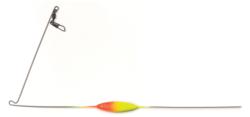 aid boat control. This L-shaped wire – the bottom bouncer – is the foundation on which some of the top walleye pros break down structure to the point of microscopic details. And it’s this attention to detail acquired through primitive means that can pay big dividends come late summer or early fall when many natural-lake patterns traditionally turn off.
aid boat control. This L-shaped wire – the bottom bouncer – is the foundation on which some of the top walleye pros break down structure to the point of microscopic details. And it’s this attention to detail acquired through primitive means that can pay big dividends come late summer or early fall when many natural-lake patterns traditionally turn off.
It’s a well-known fact that early to midsummer periods hold some pretty stable patterns that are productive for masses of anglers. The schools of walleyes are generally large, and many of these fish are utilizing easy-to-find shallow flats and other types of structure. It’s a prime situation where most anglers can locate and catch fish. But the end of summer brings change.
“Smiles turn to frowns,” Olson said. “Traditionally, the bite gets tougher. We can speculate a lot of different reasons why, but I feel that the fishing pressure breaks up those large schools of fish into little pods that might number less than a dozen. This, in itself, makes fish more difficult to find and catch. What we also see is these fish often utilize open water, the basin or become very edge-orientated.”
While this usually isn’t the time of year anglers look forward to, Olson finds that these aggravating fish that become glued to subtle substrate changes or pin themselves against minute bottom-composition deviances can actually become very predictable. An angler just has to understand how to find the bottom details that hold the fish.
First and foremost, understand the limitations of electronics. Thanks to technology, anglers can tell a lot about what’s going on beneath them, even if it’s a hard bottom or soft. But it’s what they can’t tell that can make a big difference. Can a unit tell whether the angler is moving from rocks the size of fists to rocks the size of bowling balls if the depth doesn’t change much? What about the change from silt to a sticky clay substrate? These differences on sonar are minute and very hard to distinguish, especially if there is nothing relative to compare with or if an angler is over water he has never fished. This is where a bottom bouncer can shine.
“A bottom bouncer is one of the greatest tools for boat control because you can feel every little change in the bottom,” Olson said.
A bottom bouncer transmits a continuous telegram of sorts up the line, letting the angler feel every bump and change in the bottom with a detail not found on other presentations. The effectiveness of the bottom bouncer’s telegraphic traits is tied to its wire construction. This wire essentially transmits and magnifies every detail as if the rod tip, itself, was being dragged along the bottom of the lake.
Imagine a transition on the basin of a natural lake where a soft, mucky silt bottom changes to a band of sand, which then gives way to scattered rocks the size of landscape rocks and eventually changes to a small spine of larger rocks the size of pumpkins. Now imagine every fish is holding right on the transition between the sand and the scattered landscape rocks. That may be a very tight window. So how does an angler perfect boat control to find these sweet spots again and again? He does it by going back to the days of the telegram.
“I can tell when big rocks become small rocks, or I can feel the wire of the bottom bouncer sink into mud when I drop down,” Olson said. “This extra intimacy of the lake bottom is often what helps me fine-tune patterns.”
Another tour angler, Ranger pro Troy Morris of Bismarck, N.D., is a fan of bottom bouncers when searching out walleye-holding structures.
“What we find when breaking down these transitions and structures with bottom bouncers is how amazingly edge-related walleyes are,” Morris said. “These fish are so particular about where they stage or how they move across these transitions that if you don’t have the detail of the bottom composition that a bottom bouncer gives you, it can sometimes feel like you’re fishing blind. I feel much more confident when I have this information – the lake feels smaller.”
He stressed that the best bouncers for bottom exploration have the weight or lead farther up the wire, closer to the arm. And he prefers the traditional L-shaped models, as opposed to the smaller walking-sinker models. This style lends for a more vertical or 45-degree presentation for enhanced boat control.
Morris is also careful about selecting the proper weight of bottom bouncer to match his speed and keep the lure running above bottom.
“I pull fast enough to where the bottom bouncer does not drag on bottom,” Morris said, “and I will drop my rod tip back approximately 1 foot, and if it touches bottom, that’s where I want to be.”
The short drop indicates the bottom bouncer is right above bottom, and it gives Morris an advantage when determining the exact locations of fish.
“This isn’t a situation for dragging,” Morris said. “Use enough weight to keep the presentation up and down so that when you either hit fish or find these changes, your waypoints are closer to where your bottom bouncer actually was. On real sharp structure, I am often just using one rod and reeling up and dropping down all of the time to feel my way through the structure.”
In addition to using one rod on steep breaks, Morris will go short with his leader. A shorter leader will result in fewer hangups when traveling up and down the break. On large flats, however, Morris’ leader may reach 6 feet. Olson, on the other hand, rarely goes longer than 5 feet with his leader, unless he is using floating beads to keep the bait suspended. In the end, leader length is about control, and many factors can determine how long to go.
“What often happens on the transitions of basins is mayfly hatches cloud the bottom with dead carcasses, emerging insects and other clutter,” Olson said. “When that happens, you have to get higher than the clutter you see on your sonar. This is where either a longer snell or float will help you ride above the bugs.”
Both pros prefer crawler harnesses and spinners with their bottom bouncers, but it is important to match the size of the blade to the speed of movement to ensure the blade is actually turning. Many anglers learning to use bottom bouncers have spent outings fishing with harnesses dressed with blades that weren’t spinning.
Morris recommended traditional monofilament for snells, but Olson likes 8-pound fluorocarbon, especially in clear water, although floating beads are often needed to keep the sinking line off bottom on long leaders. For the main line, the no-stretch, abrasion resistance of superlines like Berkley FireLine is crucial, as is a high-modulus, fast-action graphite rod, although rod selection is more about sensitivity than imparting action on the lure.
“More often than not, it’s not an aggressive action,” Olson said. “I don’t pump it, and I don’t do any extra action with the rod.”
A baitcaster is the best choice for easily releasing and retrieving line if the depth changes. Olson recommended the Shimano Castaic. It has a feature known as Instagage II, which is similar to a flipping switch. After releasing line, an angler can engage the reel again with just his thumb. Thus, one-hand operation is possible, as is controlling two rods at one time.
The presentation
With the right gear, the presentation then depends on controlling the boat and the activity of the fish.
“When I’m in a mode where I’m trying to determine what’s going on,” Olson said, “I’ll go into search mode and use a crawler-spinner combination to move relatively quickly over structure to find active fish. Usually the more active fish are going to be eating and going after a spinner. With a bouncer, I can determine what’s going on with the bottom in a relatively fast patterning situation.”
Boat control is then a combination of wind and trolling-motor power. Morris prefers to drift with the wind, using the bowmount to steer and selecting the proper weight bottom bouncer to match drift speed. Olson, however, uses the bowmount to slow-troll at a speed near 1.1 or 1.2 mph, watching the graph and comparing the sonar return to the transmission through the rod in search of a pattern.
“When we use bottom bouncers to give us a mental picture of the bottom,” Morris said, “we are using this information in correlation with our sonar and GPS units to be more accurate.”
“Information that we get from the bottom bouncer makes us more knowledgeable about what the sonar reveals and vice versa,” Olson agreed. “We are, in a sense, able to quickly calibrate our sonar units to what is actually on the lake bottom no matter where we go to fish.”
Once a pattern is determined, perhaps a few fish are in the boat, and the pros want to dissect an area, both opt for a slightly different approach to bottom bouncing.
“If I’ve caught some fish and then it seemed to die,” Olson said, “I may switch to a sliding bottom bouncer. It allows me to do the slip-sinking scenario, but it allows me to have good contact with the bottom. It allows me to work the less- aggressive fish, and when they hit, I can feed them line. I can let the fish turn the bait around, ball the bait up and then eat the crawler. It goes from an aggressive fish-finding presentation to a finesse presentation all with a bottom-bouncer.”
When Morris fishes with a sliding bottom bouncer, he’ll actually modify his typical bouncer by clipping the wire section that is made to attach to a leader. A sliding snap swivel then keeps the bouncer on the line.
The sliding rig should be worked slower than a typical bottom bouncer, around .6 mph. And a leech or inflated night crawler replaces the spinner-harness combo.
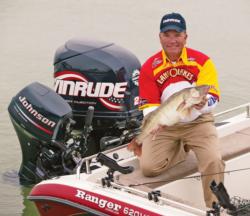 Olson also reminded anglers to never overlook the use of a marker buoy for pinpoint boat control.
Olson also reminded anglers to never overlook the use of a marker buoy for pinpoint boat control.
“Often, these locations are just bands of sand or gravel in an abyss of mud, and the sweet spots are extremely small,” Olson said. “When the spots become smaller and the presentation becomes slower and more vertical, marker buoys are still the most accurate system for repeating passes, finding the spot and staying where you need to.”
Bottom bouncers send the angler a constant telegram of information that can be used to tweak boat control, as well as to narrow down and repeat patterns. And any time walleyes are pinning themselves against subtle transitions or tight against structure, it’s this primitive information that allows the boys who love plying the lake bottom with wire and lead a chance to shine.
1 touch, 2 touch, 3 touch
When trolling for walleyes, developing a pattern is more about repeating a presentation than knowing exactly what depth triggered a bite. For bottom bouncing, it’s no different. That’s why Olson relies on the one-touch, two-touch, three-touch method.
The number indicates how many times he touches bottom with the bottom bouncer before setting it. For one-touch, Olson will drop the bottom bouncer, with the boat already moving at the desired speed, and he’ll engage the spool and fish as soon as it touches bottom. Drag on the line will lift the bottom bouncer off the bottom. To keep it closer to bottom, he’ll drop it a second time, but only after giving the rig about 10 seconds to stretch out. Tripping the spool then sets it in place. Finally, the three-touch method requires dropping the bottom bouncer a third and final time.
The three-touch is best when electronics show fish hugging tight to bottom, or when the wind is howling and the boat is surging in heavy waves. Near chunky rocks and other objects that could cause tangles, or when marking fish suspended slightly off bottom, try the one- or two-touch method. Having the bottom bouncer slightly higher allows the bait to glide over obstructions. Experiment with all three, and develop a pattern that can continuously produce.
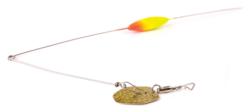
A better bottom bouncer
A bottom bouncer has traditionally been a simple piece of tackle. So long as it had a quality wire and snap swivel, it worked. But wise tournament anglers are always looking to increase the effectiveness of their tackle by making modifications, often to add attraction. Lindy Legendary Fishing Tackle took care of that at the factory when they released the Lindy Shake-E Blade Bottom Bouncer early in 2008.
Stemming from the success of the ChatterBait in other freshwater fishing circles, Lindy incorporated a vibrating blade ahead of the snap swivel that gives the lure trailing behind an erratic wobble.
Lindy also added an attention-grabbing high-visibility chartreuse-and-red paint scheme over the lead weight for even more visibility. The Shake-E Blade Bottom Bouncer comes in four sizes for most bottom-bouncing needs. (lindyfishingtackle.com)
